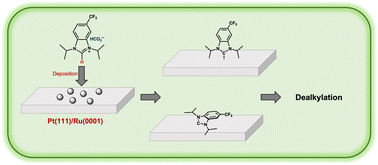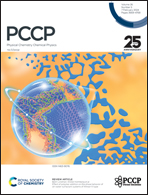N-heterocyclic carbene adsorption states on Pt(111) and Ru(0001)†
Abstract
N-heterocyclic carbene ligands (NHCs) are increasingly used to tune the properties of metal surfaces. The generally greater chemical and thermal robustness of NHCs on gold, as compared to thiolate surface ligands, underscores their potential for a range of applications. While much is now known about the adsorption geometry, overlayer structure, dynamics, and stability of NHCs on coinage elements, especially gold and copper, much less is known about their interaction with the surfaces of Pt-group metals, despite the importance of such metals in catalysis and electrochemistry. In this study, reflection absorption infrared spectroscopy (RAIRS) is used to probe the structure of benzimidazolylidene NHC ligands on Pt(111) and Ru(0001). The experiments exploit the intense absorption peaks of a CF3 substituent on the phenyl ring of the NHC backbone to provide unprecedented insight into adsorption geometry and chemical stability. The results also permit comparison with literature data for NHC ligands on Au(111) and to DFT predictions for NHCs on Pt(111) and Ru(0001), thereby greatly extending the known surface chemistry of NHCs and providing much needed molecular information for the design of metal–organic hybrid materials involving strongly reactive metals.



 Please wait while we load your content...
Please wait while we load your content...